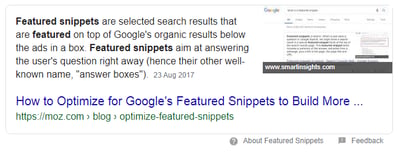Forget Position #1 - It's All About Position #0 in Search

We're an increasingly demanding nation when it comes to technology. We expect answers quickly, whether by typing a query into a search engine or asking questions of our smart speakers in our living rooms. So, it's no surprise search results are constantly evolving to meet consumer demand, and featured snippets play a big role in this.
What is a Featured Snippet?
Featured snippets are answer boxes that sit above natural results and underneath Google's paid results. Featured snippets answer a user's query quickly. Whether the user has typed the query or 'Asked Google,' they'll be presented with a concise, helpful result that answers their query.
Thanks to their positioning, featured snippets mean great visibility for the website featured, yet less visibility for other organic results. Google also recently updated how its ad results appear in search results, making them look more organic than ever. Naturally then, the number 1 position is starting to feel less valuable than in previous years.
There are four types of featured snippets: paragraph snippets, list snippets (with bullets or numbers), video, and table snippets. Paragraph snippets are served the majority of the time (82% according to Getstat).
Here's an example of a featured snippet (paragraph snippet) in Google's search results:

What are the Benefits?
Featured snippets can be incredibly powerful when it comes to SEO. Unlike ranking organically, authority and brand signals don't play as much of a role - in fact, you can surpass big publications and competitors and make your way to position 0.
Not only do featured snippets increase brand exposure, they can also increase click through rate and traffic when you're a featured result. If competition levels make it impossible to reach position 1 organically, featured snippets could be your answer.
So, what's the catch? In order to claim a featured snippet, Ahrefs found you must already be ranking on page 1 (top 10 results) of Google search results for a query. This ensures Google is selecting answers from relevant sources.
But you can make your way to #0 by following a few simple optimization rules:
How to Bag Yourself a Featured Snippet
1. Keyword research is key
Featured snippets are usually triggered by long tail keywords. This is no surprise considering the increasing way we are searching with voice and conversational language. Data suggests voice search queries tend to be three-to-five keywords in length.
However, not all keywords bring up featured snippets in search results. So, to effectively perform keyword research for featured snippets, you'll benefit by using an industry-leading tool like Ahrefs or Semrush.
Once you have a list of relevant search terms, highlight those that are ranking, or have the capability to rank, higher than 10th position. These are the opportunities you want to look into.
If you're lacking in current opportunities, have a look at some question keywords or 'vs' keywords that could be incorporated into your content. These keywords are more likely to serve featured snippets. From here, you should be able to identify some related content as well.
2. Know your snippet type
Once you've identified search terms to optimize for featured snippets, identify what kind of featured snippet shows or would likely show for them. Is a list, table, video or a paragraph snippet showing? It's critical to know what you're competing for, as optimizing for a paragraph snippet is no use if Google wants to show a video at #0.
3. Get optimizing
Set character limits
A featured snippet is usually about 52 words in length. You'll want to summarize an answer on-page within this word count. Of course, you can expand further, but by having a clear summary of your answer that's the right length, you're making it easier for Google to find it. Otherwise, Google has to patch things together from long content.
Create optimized headings
Once you have a succinct answer/table/list in the text, you want an optimized heading directly above. For instance, if you are answering a question-based query, include the question as a H2 directly above your answer.
Break up content
Using images and headings to break up content can also make it easier for Google to source featured snippet text. For instance, add an image beneath your 52-word answer.
Optimize images
As with best practice SEO, make sure you include quality, optimized images with your content. If Google understands an image to be relevant to your snippet, it will likely pull this along with your content.
Include related questions
Make sure you include other related, relevant questions in your content. You may end up with multiple snippets!
Take Advantage of Featured Snippets
It's time to start taking advantage of featured snippets. Make sure you're investing time into optimization and give our top tips a go!
Adam Blackford-Mills heads up the team at MRS Digital, a leading inbound marketing agency in Hampshire, UK. With over a decade of experience in the industry, Adam ensures that MRS are at the forefront of search marketing, utilising the latest techniques and technology.








